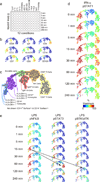Multiplexed mass cytometry profiling of cellular states perturbed by small-molecule regulators
- PMID: 22902532
- PMCID: PMC3627543
- DOI: 10.1038/nbt.2317
Multiplexed mass cytometry profiling of cellular states perturbed by small-molecule regulators
Abstract
Mass cytometry facilitates high-dimensional, quantitative analysis of the effects of bioactive molecules on human samples at single-cell resolution, but instruments process only one sample at a time. Here we describe mass-tag cellular barcoding (MCB), which increases mass cytometry throughput by using n metal ion tags to multiplex up to 2n samples. We used seven tags to multiplex an entire 96-well plate, and applied MCB to characterize human peripheral blood mononuclear cell (PBMC) signaling dynamics and cell-to-cell communication, signaling variability between PBMCs from eight human donors, and the effects of 27 inhibitors on this system. For each inhibitor, we measured 14 phosphorylation sites in 14 PBMC types at 96 conditions, resulting in 18,816 quantified phosphorylation levels from each multiplexed sample. This high-dimensional, systems-level inquiry allowed analysis across cell-type and signaling space, reclassified inhibitors and revealed off-target effects. High-content, high-throughput screening with MCB should be useful for drug discovery, preclinical testing and mechanistic investigation of human disease.
Figures






References
-
- Paul SM, et al. How to improve R&D productivity: the pharmaceutical industry's grand challenge. Nat Rev Drug Discov. 2010;9:203–214. - PubMed
-
- Nolan GP. What's wrong with drug screening today. Nat Chem Biol. 2007;3:187–191. - PubMed
-
- Kola I, Landis J. Can the pharmaceutical industry reduce attrition rates? Nat Rev Drug Discov. 2004;3:711–715. - PubMed
-
- Kramer JA, Sagartz JE, Morris DL. The application of discovery toxicology and pathology towards the design of safer pharmaceutical lead candidates. Nat Rev Drug Discov. 2007;6:636–649. - PubMed
-
- Kolch W, Pitt A. Functional proteomics to dissect tyrosine kinase signalling pathways in cancer. Nat Rev Cancer. 2010;10:618–629. - PubMed
Publication types
MeSH terms
Substances
Grants and funding
- T32 CA009302/CA/NCI NIH HHS/United States
- R01 CA130826/CA/NCI NIH HHS/United States
- P01 CA034233/CA/NCI NIH HHS/United States
- U19 AI100627/AI/NIAID NIH HHS/United States
- F32 GM093508/GM/NIGMS NIH HHS/United States
- T32 AI007328/AI/NIAID NIH HHS/United States
- F32GM093508/GM/NIGMS NIH HHS/United States
- U54 CA149145/CA/NCI NIH HHS/United States
- HHSN272200700038C/AI/NIAID NIH HHS/United States
- HHSN268201000034C/HL/NHLBI NIH HHS/United States
- U19 AI057229/AI/NIAID NIH HHS/United States
- T15 LM007033/LM/NLM NIH HHS/United States
- 1R01CA130826/CA/NCI NIH HHS/United States
LinkOut - more resources
Full Text Sources
Other Literature Sources

